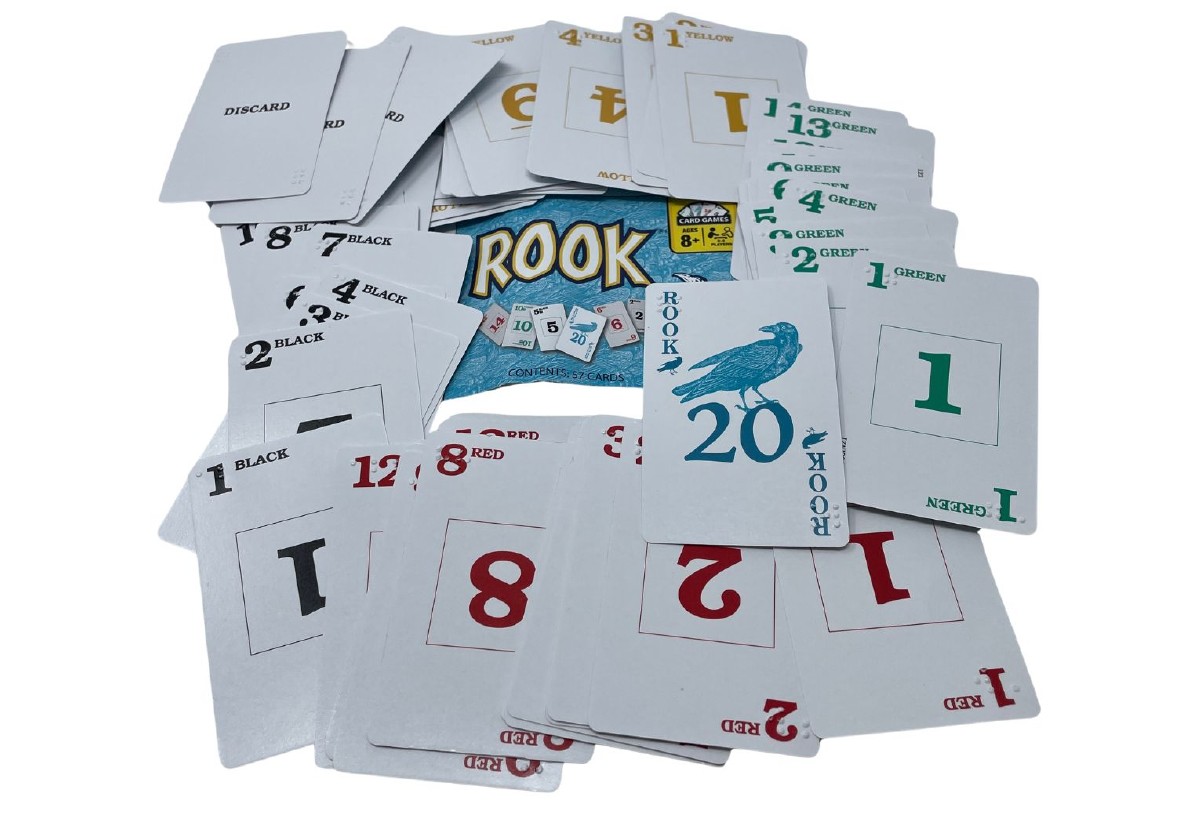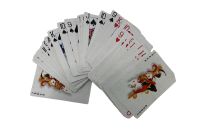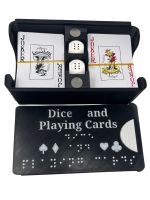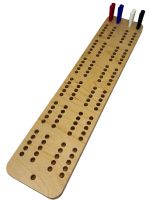
Braille Rook Cards
Product Features
- The best card game you're not playing.
- Simple rules, yet complex strategy.
- Learn in minutes, then join right in.
- Deck includes 56 brand-name playing cards.
- Cards sport Braille on two corners, and full-color printing.
- Deck comes packed in a hard-Plastic case.
- Recommended for ages 8 and up.
- Package Weight: about 4 ounces.
Product Description
The best card game you're not playing! Since 1906, card players have been enjoying this awesome family game! It's easier than Bridge, more challenging than Hearts, and unpredictable until the last card. Bid, name trump, and take as many tricks as you can ... but look out for that rook! The ultimate wild card, this big bird can swoop in and change everything!This deck includes 56 cards, in four colors, plus the Rook. Each colored set is numbered 1 to 14, and the numbers and colors are marked in clear, crisp Braille. The rules we've posted here make the game simple, even for well, rookies. Comes in a sturdy, hard-plastic box for easy storage.
So pick up a deck of Rook cards, and break it out the next time you have a gathering of family or friends. Even if some or all have never played, the rules of Rook can be taught in a few minutes, and most players find it interesting and enjoyable right away. Card games have traditionally been a great way to socialize, and Rooks unique variety of simple rules and complex strategies will appeal to almost everyone! Recommended for ages 8 and up.
How to Play Rook
Directions courtesy of Future Aids, The Braille Superstore.
Rook is a game that both the young and old can enjoy together, which in this day and age is a rare commodity indeed. As I, Danny, am a great fan of Rook, I was chosen by Future Aids to draw up a set of rules to get you started in playing the game.
Now, even though the rules to follow are fairly extensive, Rook is not a difficult game to play. So don't let this introduction to Rook scare you off. Once a few people know how to play, others can be taught easily. I myself glanced at a book of rules before playing my first hand, and was rather overwhelmed. However, the first time I played Rook, everyone played an open hand. That means we all discussed our cards, and the other players advised me what to play. After that I was "off and sailing," as they say.
The introduction's over. So, that disclaimer not withstanding, let's delve into the exciting card game of Rook.
The Basics
Rook is a card game originally created in 1906 by Parker Brothers. A deck of Rook cards consists of four colors (black, red, yellow, and green) each numbered 1-14, with a special "Rook card", which is basically a picture of the Rook bird. Though rules can vary greatly (more on this later), typically Rook is played as a bidding game. In this respect it is similar to Pitch, Spades or Pinochle, where players bid based on how many points they feel they can take through the course of a hand. Though you almost always have help from at least one partner, you are not allowed to discuss your cards with other players. Thus, it's difficult to count on your partner(s) while bidding, you must decide how many tricks you can take on your own. Each round every player plays a card, and in general the high card wins the "trick". When all cards have been played, a team totals up the cards that count as points to determine if they win the hand.
Unlike Spades, however, the winning bidder also wins the right to name whatever color he wants to be "trump." The trump color is then regarded as the superior color throughout that hand, meaning that it will take tricks of other colors, regardless of value. Veterans of Pinochle and Bridge will be familiar with the importance of naming a good trump based on the cards in your hand, and the tactics involved in striking a balance between your trump and the amount you bid. While it is a simple concept, to successfully bid and win in any bidding card game takes skill, strategy, and more than a little bit of luck in most cases.
Rules of Play
There is no one set of rules for playing Rook. The official instructions themselves included in Rook decks list 5-6 different playing methods, and many more variations exist. What follows is a basic outline of the rules of Rook as it is played by my family and friends. These rules can be used to play with between 3-7 players. Obviously I believe this is the best way to play Rook, but of course your mileage may vary, and I invite you to experiment as you see fit. Aside from a deck of Rook cards, a pen and paper to keep score, and a medium sized table for play, all you need now is a few friends and your beverages and refreshments of choice.
When playing with just three players, the partners are the ones who do not win the bid, and the person who names Trump is alone. In four- or six-handed Rook there are two teams of either two or three people, the teams comprised of every other person around the table. The most unpredictable form of Rook is played with five or seven players. In this event, the person who wins the bid names a secret partner, by announcing "The person with the Green 14 is my partner." In the case of seven-player, he or she may call two partners in this manner.
1 is considered the highest card, with 2 the lowest. There are four point cards within the numerical cards: 1, 14, 10, and 5. Generally the 1 is worth 15 points, 14's are worth 10 points, 10's are worth 10 points, and 5's are worth 5 points. The Rook card, which is always the lowest possible trump (no matter what color is named trump), is worth 20 points. In addition, whoever takes the most tricks is awarded 20 points. This makes for a total of 200 points in each hand of Rook.
The deal proceeds much like it does in most card games, both the deal itself and next dealer responsibility rotate in a clockwise fashion around the table. The number of cards each player is dealt depends on how many people are playing as follows:
3 players: 17 cards each, 6 in the Kitty
4 players: 13 cards each, 5 in the Kitty
5 players: 11 cards each, 2 in the Kitty
6 players: 9 cards each, 3 in the Kitty
7 players: 8 cards each, 1 in the Kitty
The Kitty consists of left-over cards, which are dealt in the middle of the table. This Kitty is won by whoever wins the bid, who then has the option of using any or all of the cards in the Kitty for his hand. He must discard the same number of cards from his hand he doesn't want, though obviously he should not discard trump.
Bidding
Bidding starts off at 100 points, and increases in minimum increments of 5 points from there, though players can increase the bid in larger increments if they wish. By bidding 100 (as an example), you are saying that you will take 100 points during the play of the hand, which is also known as "making the bid." If your team succeeds in making the bid, you score 100 points, plus however many points above your bid you manage to take. If you fail to make the bid, you lose the amount of your bid, in this case 100 points. There are no "sandbags" in Rook (penalties for underbidding your hand), nore "going nil" (making a certain number of points by not taking any points at all). A player may announce his intent to "Shoot the Moon," however, which means he is awarded twice the points if he wins, and loses twice the amount bid if he fails to make the bid. Though it is almost unheard of in Rook, a player may also announce his intention to "Shoot the Blue Moon," which means he makes 400 points if he takes every point card (thereby collecting 200 points), and loses 400 points otherwise.
Once the bid has been placed (remember to write it down!), the bidder picks up the Kitty. He then discards six cards from his hand he doesn't want, which are not shown to anyone else. The idea is to discard low cards, point cards (as the person who takes last trick gets the discard), or attempt to get rid of an entire color in your hand, so you can trump in that color right away. The person who won the bid then names Trump, which is recorded on the score sheet.
Playing the Hand
Play begins with the person to the left of the player who won the bid, who leads with whatever card he or she wishes. Unless he or she has been named as a secret partner in the case of 5 or 7-player, the first trick is always led by the opposing team. Therefore, since the winner of the Kitty should have the most cards in Trump, it is not a good choice for the opposing team to lead in Trump. Play continues clockwise around the table from whomever led the trick. Each player must play a card on each trick, and whomever wins the trick must then lead off the next trick.
Players must follow the color suit led whenever possible, unless they have no more of the color. In this event they are free to play any card they choose, or they may "trump it." If trump is played on any trick, high trump wins the trick, regardless of the numerical values of the non-trump cards. The Rook is considered trump in each hand, so if a player has no more trump color to play on a trump-led trick, the Rook must be played to follow suit.
Each trick is taken in by the team who wins the trick, until all tricks have been played. The team that takes the last trick wins the bidders discard as well. Points are then tallied by each team to determine if the bidder made his bid or not.
The non-bidding team gains the amount of points they take regardless. The bidding team either makes the points they took if that total is over their bid, or loses their bid in points. The bidding team can never lose more points than they bid in one hand, regardless of how few points they took.
Winning the Game
Play continues for as many hands as are necessary for one team to reach 500 points, which is considered game point. Depending on who makes bids or loses them, and by how many points, a game can be over in as little as 3 hands, or continue indefinitely. Should both teams eclipse 500 points on the same hand, the bidding team is considered the winner, regardless of actual point totals. This is known as "bidder goes," and basically rewards the bidding team, rather than allowing a team very close to 600 points to simply "coast out."
Strategy
Although the rules and concepts are relatively simple, Rook, like most other partner bidding card games, requires a lot of practice, skill, and intuition by a player to become really good. To me, Rook offers a variety of subtle differences from other card games that really allow for deeper strategic thinking and exciting play. Unlike Spades, success is not dependent on receiving good cards in one suit. Unlike Pitch, Rook has enough depth of cards that it will not be immediately obvious after two tricks who has what cards, and making bids requires skillful card play as well as skillful bidding. Also, the outcome of hands are not pre-determined, like they sometimes are by melds in Pinochle.
Below are a few general observations and strategies I have picked up over my years of playing. These strategies are by no means complete or fool-proof, but rather general truisms I generally fall back on when in doubt. Really, the best way to get a feel for the game is to simply play. You will undoubtedly make some silly plays early on, but as they say, experience is the best teacher.
*Don't overbid your hand. This probably seems obvious, but with 17 cards in your hand in the case of three-player, sheer numbers can fool an inexperienced player into thinking they have a better hand than they actually do. In general, you're going to want almost half the cards in your hand to be Trump, the more the better obviously. It's always preferable to have the 1 or the 14 in your trump, so you can have at least one guaranteed trick to hopefully take a Rook with. Also, unless your trump is very strong, don't rely solely on it. A lot of points can be taken in the off-suits, so make sure you have some other decent cards.
*Take control early. It is always to your advantage to lead the trick, giving your partner(s) a chance to "throw points," but ultimately allowing you to force other players into playing point cards. If you allow other players to lead the first few hands, your opponents will collect most of the valuable cards and you will most likely lose very badly.
*Always lead trump. If you are the bidder, ideally you will have more trump than anyone else at the table (you hope). Thus, if you can run everyone else out of trump early, you will be in a much better situation later in the hand. Leading trump early, and often, not only allows you to more easily dictate the game to your will, it can help ensure you will take the last trick, which means you can hide point cards in the discard safely. Also, the Rook card, at 20 points, is so important it's usually worth using high trump early on to secure it, or burning trump to get the Rook that may be hidden deep in another players hand. Even if you have to sacrifice a 10 of trump, you'll still be up 10 points if it allows you to take the Rook.
*Don't bid on the Kitty. Although a good Kitty can greatly increase the quality of your hand, you shouldn't come to depend on it. For every Kitty filled with 1's and 14's, there will be one filled with 6's and 8's. Also, just because a Kitty might have high cards or a lot of cards in one color doesn't necessarily mean it will help your hand. Five red in the middle doesn't help much if you only have one in your hand to begin with.
*Count cards, especially in trump. Smart players will mentally keep track of what 1's and 14's have been played in each suit, so that they can take advantage of it late in the hand with 13's and 12's. In trump this is especially important; a good player will keep track of how many trump have been played, as well as which high cards have come out.
*Minimize one or two off-colors whenever possible. If you can get rid of one or two non-trump colors in your hand, you are in a much better position to "trump" a particular trick, and take points the other team would have ordinarily gained. If you bid and can discard an entire color, it is usually advisable to do so. Likewise, if you have the opportunity to burn a card during play, always look to burn cards from your weakest suit. This is known as short-suiting yourself.
*Identify yourself if you're a secret partner. Don't wait until the last trick to play the card the bidder designated as a partner card. Even if the trick is already secured by the the bidder, it's important for everyone to know who's side you're on. Don't waist the 1 in trump, but don't hide in the bushes too long either.
*Most importantly, have Fun. If my description has intrigued you, I invite you to pick up a deck of Rook cards, and break it out the next time you have a gathering of family or friends. Even if some or all have never played, the rules of Rook can be taught in a few minutes, and in my experience most people find it interesting and enjoyable straight off. Card games have traditionally been a great way to socialize, and Rooks unique variety of simple rules and complex strategies will appeal to a wide variety of people.












